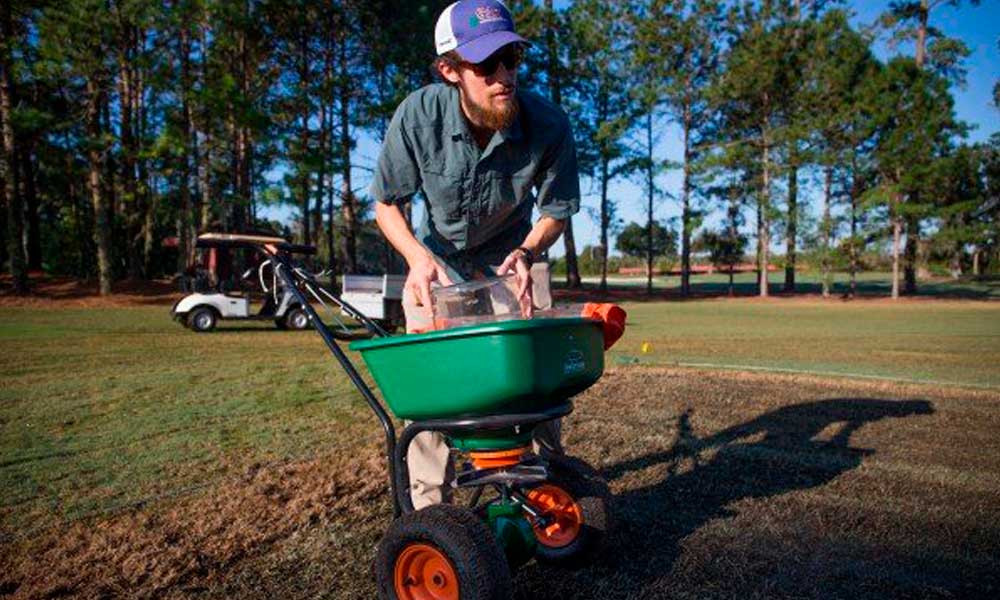UF/IFAS Researcher Hopes to Bolster Pollinators, Reduce Water Use, Other Inputs on Golf Courses


This spring, a handful of golf courses in Florida will become a little more “green,” thanks to a new project led by a University of Florida Institute of Food and Agricultural Sciences Extension specialist and researcher.
“In our state, resource conservation is a big issue, especially water conservation,” said Adam Dale, a UF/IFAS assistant professor of entomology. “Other big issues include pollinator conservation and insect pest management. Both of which are connected to the vitality of our ecosystems.”
According to Dale, golf courses could be used to conserve pollinators while reducing water consumption and management inputs such as pest control.
“Golf courses have a reputation for the resources used to maintain them,” Dale said. “In Florida, the majority of golf course acreage is irrigated, but 40 to 70 percent of that area isn’t typically played. What if we took some of that under-played space and turned it into drought tolerant functional habitats for pollinators and other beneficial insects?”
Over the summer, Dale worked with Paul Hamilton, superintendent at Mark Bostick Golf Course on the UF campus, and superintendents at two other courses—On Top of the World and Adena, both in Ocala—to plan and establish two wildflower plots on each course. Each plot is 4800 square feet, nearly twice the area of a standard tennis court.
Dale has just finished planting wildflower seeds on each golf course. The seeds will sprout and bloom in spring of 2017.
“People don’t often realize it, but golf courses could be a valuable resource for conserving habitat and beneficial insects,” said Dale. “Golf courses are massive areas of vegetative habitat—the average course in Florida is about 120 acres—often located where natural habitats have been disturbed by urban development.”
Dale is collecting data on the biodiversity in and around the plots to determine how the wildflowers impact the pollinator population in the area. He and his team are also looking for beneficial insects, such as predators and parasitoid wasps, that help control damaging pests, he said.
In addition, Dale will track how much water, fertilizer, and other inputs are saved by converting these plots from managed turf to wildflowers.
The plots have signage adjacent to them explaining the project to golfers and other visitors, said Dale. “Another reason I wanted to do this was to engage the community and help people learn the potential ecological benefits of golf courses,” he said.
Over the course of the project, Dale will create a set of guidelines for golf course superintendents that will help them create and maintain their own wildflower habitats. “From a superintendent’s perspective, wildflowers can add aesthetic appeal that attracts people,” he said. “The golf course can also demonstrate that it’s doing something to benefit the environment.”
Recent Posts
One of the Biggest Jobs in Golf
When Rory McIlroy finally slipped into the Green Jacket on Sunday, April 13, 2025, after…
Audubon International Marks Earth Day In Growth Mode
As the world celebrates Earth Day on April 22, Audubon International – the environmentally focused non-profit…
Help keep golf sustainable by bidding in GCSAA’s Rounds 4 Research online auction
In celebration of Earth Day, you can help fund the research that advances golf’s environmental…
Five Cabot Golf Courses Place in Golfweek’s Prestigious 2025 Top 100 International Courses List
Cabot, a developer and operator of luxury resort and residential golf destinations, is proud to…
Champion Hills Rebuilds with Heart: A Story of Resilience and Restoration
When Hurricane Helene swept through in late September 2024, Champion Hills Golf Club faced a…
Discover the New Graves Golf Club: A Game-Changing Facility in Edmond, OK
Graves Golf Club, the much-anticipated golf and training destination founded by celebrated instructors Tim and…


